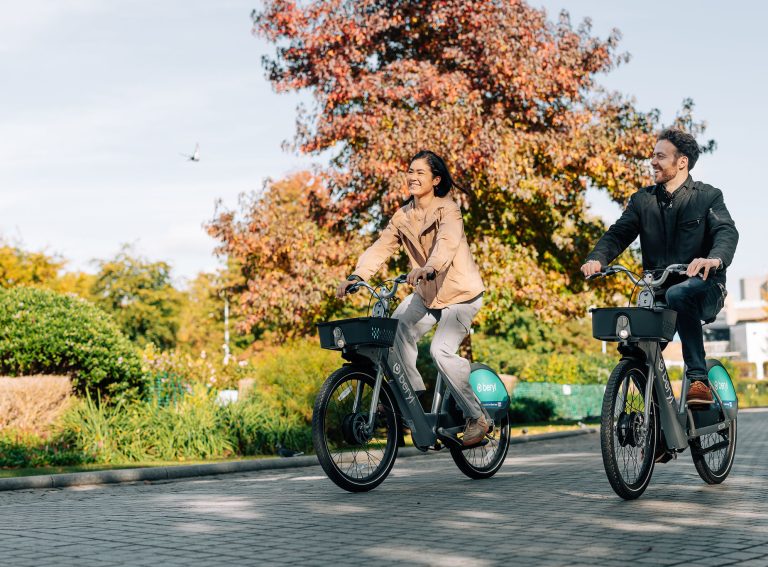Author: Scott Shepard, Head of Policy and Government Affairs, Drover AI
Over the past several years micromobility has evolved from a collection of modes (dockless e-scooters and dockless bikeshare) with minimal regulations in place across countless North American, European and Asian cities, to one that is highly restricted based upon a maximum number of operators, caps on fleets, and restricted riding zones (geofencing).
Here we examine this evolution by conducting a global survey of regulations and legislation across multiple cities to better understand how current and future public policy can be developed to ensure micromobility’s long term sustainability.
Micromobility public policy snapshot
Over the past four years we have gone through several phases in the evolution of micromobility public policy, legislation and regulation.
Today the market has reached a level of maturity in governance, and in the relationship between operators and the public sector. Specifically, what’s in focus now is the tendering and procurement of multi-year micromobility operational contracts (each of which incorporate fleet caps, maximum # of operators and stringent safety requirements).
Tech-enabled regulation & enforcement
Throughout this evolution in regulation and changing emphasis between private and public sector stakeholders, there is an overarching trend. And that is: tech-enabled regulation and enforcement is being scaled to address the range of safety concerns that regulators have been struggling with since the advent of micromobility.
As a result, micromobility operators are now being tasked with delivering solutions that reduce injuries and prevent infractions in the public right of way. What has been a pain point for cities is the management of sidewalk circulation and reduction of conflicts between pedestrians and micromobility users. In addition, the improper parking and storage of micromobility devices has caused much consternation by cities, many of which seek to support shared modes of mobility but have struggled to regulate effectively, and at the same time align with Vision Zero policies.
As a result, cities are now demanding that better safety measures be implemented when applying for permit renewals or submitting bids for new multi-year public tenders.
As noted in a previous article by Drover’s Co-Founder Alex Nesic, cities don’t have the resources or bandwidth to deal with reactive enforcement, operators lose money and credibility, riders endure a cumbersome user experience, and other stakeholders (pedestrians, persons with disabilities, private property owners) are left holding the bag.
Therefore, tech-enabled solutions that incorporate AI and computer vision capabilities are being leveraged by many micromobility operators to solve these challenges. As such, regulatory compliance is now being achieved, in spite of the deficiencies in physical infrastructure and lack of resources to proactively enforce the public right of way.
Policy & regulatory case studies
We have run a global survey of recent micromobility policy, legislation and regulations.
The case studies outline public sector market demand for better safety measures to be employed by operators to ensure micromobilty’s long term sustainability in cities.
Chicago
Chicago first launched its Scooter Share Pilot Program through two separate e-scooter pilot evaluations in 2019 and 2020. As a result of the pilot programs, a public RFP for three operational permits was announced in early 2022. The new safety regulations incorporated in the RFP highlight that each scooter must be equipped with a system that sounds an alarm when it is ridden on Chicago’s sidewalks. The alert would be similar to the one made by cars when a drivers’ seat belt is not engaged, to alert both the rider and nearby pedestrians that the scooter is being operated in the wrong place.
Madrid
Madrid has taken a comprehensive approach to the incorporation of parking and sidewalk safety regulations in the enforcement of micromobility within its jurisdiction.
Specifically, recent legislation enacted on October 10, 2022 stipulates that Madrid seeks to harmonise the different uses, including pedestrian, circulation, parking, sports and leisure, and make them compatible in a balanced way with the guarantee of road safety, the mobility and fluidity of traffic, the protection of the environment and the protection of the integrity of public and private spaces. Madrid has also incorporated in its October 2022 micromobility public tender the safety requirements for 1.) minimising the possibility of improper parking among users and 2.) minimising the possibility of circulation on sidewalks and through prohibited areas by users.
New York City
New York City (NYC DOT) just unveiled the results of the East Bronx Shared E-Scooter Pilot. This pilot was the first step towards city-wide adoption of micromobility in New York, beyond existing docked bikeshare programs, such as Citi Bike.
As a result of the program, NYC DOT has emphasised the following safety priorities: 1.) Explore tools to mitigate poor riding behavior, including underage riding, multiple riders using a single vehicle, and sidewalk riding, and 2.) to increase helmet usage among riders and explore alternative parking solutions to reduce sidewalk clutter and improve user compliance.
The pilot results also described how current GPS technology has not worked as suggested by industry operators and in some instances successful policy outcomes are reliant on good user behavior. New AI / computer vision sensing technologies such as Drover’s PathPilot Lite are being developed that address some of these issues. NYC DOT has also issued an RFP to further expand micromobility, with the capacity to make the program permanent.
Shared mobility is here to stay
As succinctly described by micromobility expert Peter Griffiiths in the recent Episode 4 of The #CitiesFirst Podcast, shared mobility is here to stay. The fact that cities are provisioning scooter parking corrals and other infrastructure improvements demonstrates that cities take these modes seriously and want to incorporate them into the mobility ecosystem.
In addition, the proliferation of public tenders demonstrates that regulators want to ensure these devices are procured in such a way that they will be balanced, equitable, and safe.
As a result, tech-enabled regulation and enforcement is the sensible way forward to bridge the gaps in the ecosystem. Solutions such as Drover AI’s PathPilot Lite help operators proactively comply with safety policies and ensure that cities can benefit from these new sustainable modalities while minimising potentially problematic outcomes.











